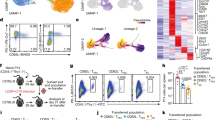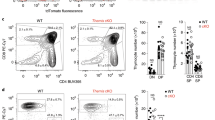Abstract
Peripheral tolerance is essential for immunological homeostasis. Tolerant T cells are thought to arise after T cell receptor ligation in conditions that are nonpermissive for replication. Here we have investigated the function of the cell cycle inhibitor p27Kip1 in tolerance induction in vivo using naive T cell receptor–transgenic cells lacking the cyclin-dependent kinase (Cdk)–binding domain of p27Kip1(p27Δ). Wild-type but not p27Δ cells underwent tolerization. Tolerized wild-type cells had impaired Cdk2 and Cdc2 kinase activity and failed to phosphorylate the checkpoint inhibitor Smad3, leading to enhanced expression of the Cdk inhibitor p15. In contrast, p27Δ cells proliferated in tolerizing conditions because of Cdk kinase activation and phosphorylation of Smad3, which resulted in no upregulation of p15. Smad3 'knockdown' prevented tolerance induction, whereas expression of a Smad3 mutant resistant to Cdk-mediated phosphorylation recapitulated molecular and functional events of tolerance. Thus, p27Kip1 is required during induction of tolerance and Smad3 regulates T cell responses 'downstream' of p27Kip1.
This is a preview of subscription content, access via your institution
Access options
Subscribe to this journal
Receive 12 print issues and online access
$209.00 per year
only $17.42 per issue
Buy this article
- Purchase on Springer Link
- Instant access to full article PDF
Prices may be subject to local taxes which are calculated during checkout








Similar content being viewed by others
References
Jenkins, M.K. The role of cell division in the induction of clonal anergy. Immunol. Today 13, 69–73 (1992).
Powell, J.D., Lerner, C.G. & Schwartz, R.H. Inhibition of cell cycle progression by rapamycin induces T cell clonal anergy even in the presence of costimulation. J. Immunol. 162, 2775–2784 (1999).
Boussiotis, V.A. et al. p27kip1 functions as an anergy factor inhibiting IL-2 transcription and clonal expansion of alloreactive human and murine helper T lymphocytes. Nat. Med. 6, 290–297 (2000).
Russo, A.A., Jeffrey, P.D., Patten, A.K., Massague, J. & Pavletich, N.P. Crystal structure of the p27kip1 cyclin-dependent-kinase inhibitor bound to the cyclin A-Cdk2 complex. Nature 382, 325–331 (1996).
Sherr, C.J. & Roberts, J.M. Living with or without cyclins and cyclin-dependent kinases. Genes Dev. 18, 2699–2711 (2004).
Sugiyama, Y. et al. Direct binding of the signal–transducing adaptor Grb2 facilitates down-regulation of the cyclin-dependent kinase inhibitor p27kip1. J. Biol. Chem. 276, 12084–12090 (2001).
Besson, A., Gurian-West, M., Schmidt, A., Hall, A. & Roberts, J.M. p27kip1 modulates cell migration through the regulation of RhoA activation. Genes Dev. 18, 862–876 (2004).
Cheng, M., Sexl, V., Sherr, C. & Roussel, M. Assembly of cyclin D–dependent kinase and titration of p27kip1 regulated by mitogen-activated protein kinase kinase (MEK1). Proc. Natl. Acad. Sci. USA 95, 1091–1096 (1998).
Aleem, E., Kiyokawa, H. & Kaldis, P. Cdc2–cyclin E complexes regulate the G1–S phase transition. Nat. Cell Biol. 7, 831–836 (2005).
Matsuura, I. et al. Cyclin-dependent kinases regulate the antiproliferative function of Smads. Nature 430, 226–231 (2004).
Fero, M.L. et al. A syndrome with multiorgan hyperplasia with features of gigantism, tumorigenesis and female sterility in p27kip1-deficient mice. Cell 85, 733–744 (1996).
Nakayama, K. et al. Mice lacking p27kip1 display increased body size, multiple organ hyperplasia, retinal dysplasia an pituitary tumors. Cell 85, 707–720 (1996).
Kiyokawa, H. et al. Enhanced growth of mice lacking the cyclin-dependent kinase inhibitor function of p27kip1. Cell 85, 721–732 (1996).
Tsukiyama, T. et al. Down-regulation of p27kip1 expression is required for development and function of T cells. J. Immunol. 166, 304–312 (2001).
Kwon, T.K., Buchholz, M.A., Ponsalle, P., Chrest, F.J. & Nordin, A.A. The regulation of p27kip1 expression following the polyclonal activation of murine Go T cells. J. Immunol. 158, 5642–5648 (1997).
Boonen, G.J. et al. CD28 induces cell cycle progression by IL-2-independent down-regulation of p27kip1 expression in human peripheral T lymphocytes. Eur. J. Immunol. 29, 789–798 (1999).
Appleman, L.J., Berezovskaya, A., Grass, I. & Boussiotis, V.A. CD28 costimulation mediates T cell expansion via IL-2 independent and IL-2 dependent regulation of cell cycle progression. J. Immunol. 164, 144–151 (2000).
Nourse, J. et al. Interleukin-2-mediated elimination of the p27kip1 cyclin-dependent kinase inhibitor prevented by rapamycin. Nature 372, 570–573 (1994).
Wells, A.D., Walsh, M.C., Sankaran, D. & Turka, L.A. T cell effector function and anergy avoidance are quantitatively linked to cell division. J. Immunol. 165, 2432–2443 (2000).
Greenwald, R.J., Boussiotis, V.A., Lorsbach, R.B., Abbas, A.K. & Sharpe, A.H. CTLA-4 regulates peripheral T cell tolerance in vivo. Immunity 14, 145–155 (2001).
Kubsch, S., Graulich, E., Knop, J. & Steinbrink, K. Suppressor activity of anergic T cells induced by IL-10-treated human dendritic cells: association with IL-2- and CTLA-4-dependent G1 arrest of the cell cycle regulated by p27kip1. Eur. J. Immunol. 33, 1988–1997 (2003).
Rowell, E.A., Walsh, M.C. & Wells, A.D. Opposing roles for the cyclin-dependent kinase inhibitor p27kip1 in the control of CD4+ T cell proliferation and effector function. J. Immunol. 174, 3359–3368 (2005).
Rowell, E.A. et al. The cyclin-dependent kinace inhibitor p27kip1 is required for transplantation tolerance induced by costimulatory blockade. J. Immunol. (in the press).
Zhang, S., Lawless, V.A. & Kaplan, M.H. Cytokine-stimulated T lymphocyte proliferation is regulated by p27kip1. J. Immunol. 165, 6270–6277 (2000).
Kearney, E., Pape, K., Loh, D. & Jenkins, M. Visualization of peptide-specific T cell immunity and peripheral tolerance induction in vivo. Immunity 1, 327–339 (1994).
Larsen, C.P. et al. Long-term acceptance of skin and cardiac allografts after blocking CD40 and CD28 pathways. Nature 381, 434–438 (1996).
Taylor, P.A., Noelle, R.J. & Blazar, B.R. CD4+CD25+ immune regulatory cells are required for induction of tolerance to alloantigen via costimulatory blockade. J. Exp. Med. 193, 1311–1318 (2001).
Jonk, L.J., Itoh, S., Heldin, C.-H., ten Dijke, P. & Kruijer, W. Identification and functional characterization of a Smad binding element (SBE) in the JunB promoter that acts as a transforming growth factor-β, activin, and bone morphogenetic protein-inducible enhancer. J. Biol. Chem. 273, 21145–21152 (1998).
Yang, X. et al. Targeted disruption of SMAD3 results in impaired mucosal immunity and diminished T cell responsiveness to TGF-β. EMBO J. 18, 1280–1291 (1999).
McKarns, S.C., Schwartz, R.H. & Kaminski, N.E. Smad3 is essential for TGF-β 1 to suppress IL-2 production and TCR-induced proliferation, but not IL-2-induced proliferation. J. Immunol. 172, 4275–4284 (2004).
Wolfraim, L.A. et al. Loss of Smad3 in acute T-cell lymphoblastic leukemia. N. Engl. J. Med. 351, 552–559 (2004).
Gilbert, K.M. & Weigle, W.O. Th1 cell anergy and blockade in G1a phase of the cell cycle. J. Immunol. 151, 1245–1254 (1993).
Shaffer, D.R. et al. Evidence for a p27 tumor suppressive function independent of its role regulating cell proliferation in the prostate. Proc. Natl. Acad. Sci. USA 102, 210–215 (2005).
Kehrl, J.H. et al. Production of transforming growth factor-β by human T lymphocytes and its potential role in the regulation of T cell growth. J. Exp. Med. 163, 1037–1050 (1986).
Shull, M.M. et al. Targeted disruption of the mouse transforming growth factor-β1 gene results in multifocal inflammatory disease. Nature 359, 693–699 (1992).
Gorelik, L. & Flavell, R.A. Abrogation of TGF-β signaling in T cells leads to spontaneous T cell differentiation and autoimmune disease. Immunity 12, 171–181 (2000).
Tzachanis, D. et al. Tob is a negative regulator of activation that is expressed in anergic and quiescent T cells. Nat. Immunol. 2, 1174–1182 (2001).
Massague, J., Seoane, J. & Wotton, D. Smad transcription factors. Genes Dev. 19, 2783–2810 (2005).
Chen, C.H. et al. Transforming growth factor-β blocks Tec kinase phosphorylation, Ca2+ influx, and NFATc translocation causing inhibition of T cell differentiation. J. Exp. Med. 197, 1689–1699 (2003).
Polyak, K. et al. p27kip1 a cyclin-cdk inhibitor, links transforming factor-β and contact inhibition to cell cycle arrest. Genes Dev. 8, 9–22 (1994).
Scandura, J.M., Boccuni, P., Massague, J. & Nimer, S.D. Transforming growth factor β-induced cell cycle arrest of human hematopoietic cells requires p57KIP2 up-regulation. Proc. Natl. Acad. Sci. USA 101, 15231–15236 (2004).
Wolfraim, L.A., Walz, T.M., James, Z., Fernandez, T. & Letterio, J.J. p21Cip1 and p27kip1 act in synergy to alter the sensitivity of naive T cells to TGF-β-mediated G1 arrest through modulation of IL-2 responsiveness. J. Immunol. 173, 3093–3102 (2004).
Wells, A.D., Gudmundsdottir, H. & Turka, L.A. Following the fate of individual T cells throughout activation and clonal expansion. Signals from T cell receptor and CD28 differentially regulate the induction and duration of a proliferative response. J. Clin. Invest. 100, 3173–3183 (1997).
Cardoso, A.A. et al. Ex vivo generation of human anti-pre-B leukemia-specific autologous cytolytic T cells. Blood 90, 549–561 (1997).
Acknowledgements
We thank F. Liu (Rutgers, New Brunswick, New Jersey) for providing the antibody specific for Smad phosphorylated at S212 and Smad3-Tm; J. Daley and S. Lazo (Dana-Farber Cancer Institute) for assistance with cell sorting; and G.J. Freeman and L.J. Appleman (Dana-Farber Cancer Institute) for discussions and critical reading of the manuscript. Supported by the US National Institutes of Health (AI 46548, CA104596 and AI 043552).
Author information
Authors and Affiliations
Contributions
L.L. did in vivo immunization, adoptive cell transfer, in vitro cell culture, signaling studies, immunoblot analysis, transcription assays, preparation of plasmids, transfection and flow cytometry, and prepared the first draft of the manuscript; Y.I. was responsible for mouse breeding and maintenance of the colonies, immunization, adoptive cell transfer, in vitro cell culture, immunoblot analysis and flow cytometry; A.B. provided technical support for mouse breeding and maintenance of the colonies, in vitro cell culture, signaling studies and flow cytometry; V.A.B. coordinated all steps of the project, supervised L.L, Y.I and A.B., and was responsible for preparation of the manuscript.
Corresponding author
Ethics declarations
Competing interests
The authors declare no competing financial interests.
Supplementary information
Supplementary Fig. 1
DO11.10 T cells from DO11.10 and DO11.10p27Δ mice were stimulated with various concentrations of OVA(323–339) peptide in the presence of irradiated antigen presenting cells and proliferation was assessed on d3 of culture. (PDF 25 kb)
Supplementary Fig. 2
For the intracellular IL-2 staining, CD4+ T cells were harvested from primed or tolerized recipients on day fifteen after immunization and restimulated in vitro with OVA(323–339) in the presence of antigen presenting cells for 24 hours. (PDF 27 kb)
Supplementary Fig. 3
Downregulation of Smad3 expression by shRNA. (PDF 38 kb)
Supplementary Fig. 4
Transfection efficiency. (PDF 46 kb)
Supplementary Fig. 5
DO11.10 and DO11.10p27ΔT cells were adoptively transferred into syngeneic recipients that were subsequently treated with immunizing (priming) stimulus, and cells were then purified and activation of cyclin E was examined as described in Figure 3. (PDF 45 kb)
Rights and permissions
About this article
Cite this article
Li, L., Iwamoto, Y., Berezovskaya, A. et al. A pathway regulated by cell cycle inhibitor p27Kip1 and checkpoint inhibitor Smad3 is involved in the induction of T cell tolerance. Nat Immunol 7, 1157–1165 (2006). https://doi.org/10.1038/ni1398
Received:
Accepted:
Published:
Issue Date:
DOI: https://doi.org/10.1038/ni1398
This article is cited by
-
Rethinking peripheral T cell tolerance: checkpoints across a T cell’s journey
Nature Reviews Immunology (2021)
-
MicroRNA-150 modulates intracellular Ca 2+ levels in naïve CD8+ T cells by targeting TMEM20
Scientific Reports (2017)
-
New roles for cyclin-dependent kinases in T cell biology: linking cell division and differentiation
Nature Reviews Immunology (2014)
-
The TGF-β-Smad3 pathway inhibits CD28-dependent cell growth and proliferation of CD4 T cells
Genes & Immunity (2013)
-
Differential expression of SMAD3 transcripts is not regulated by cis-acting genetic elements but has a gender specificity
Genes & Immunity (2009)



